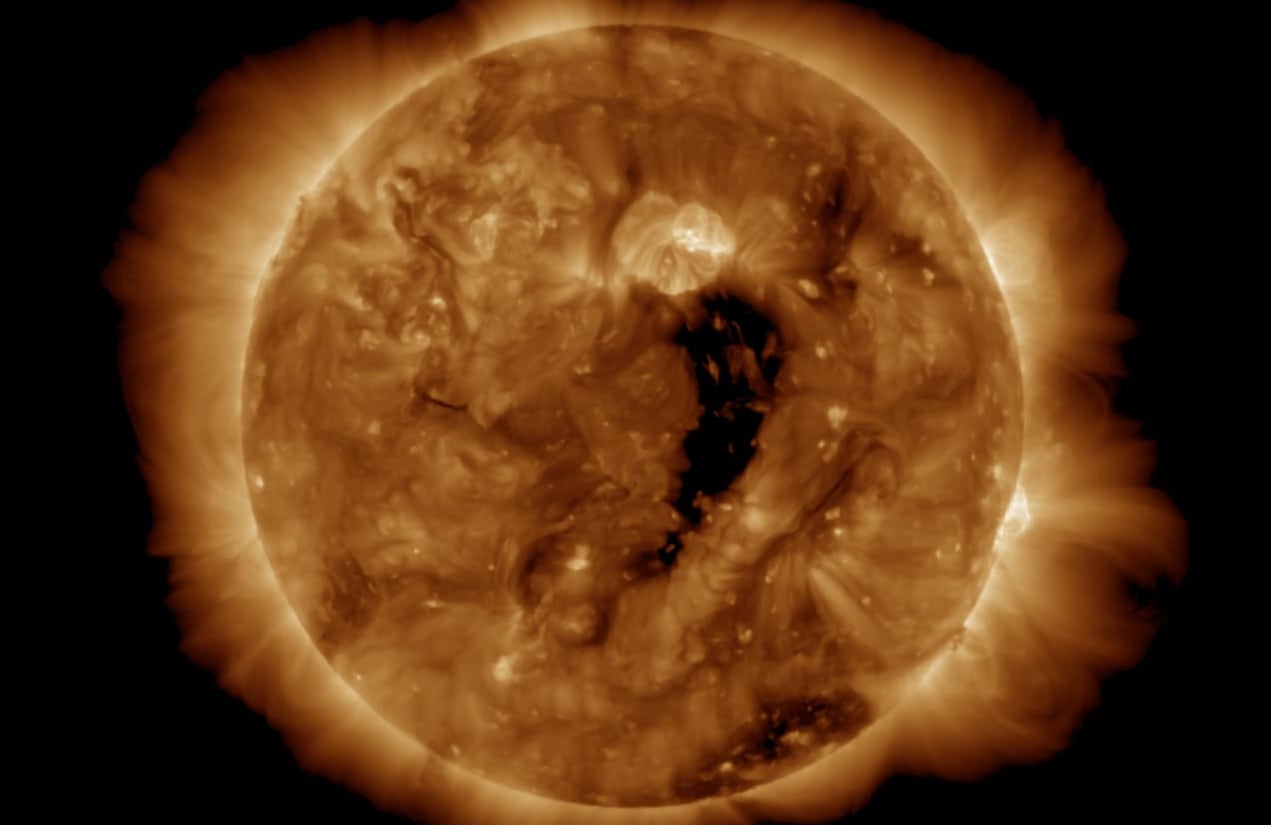Solar storm from 'canyon-like' hole in the sun could hit Earth as soon as Thursday (Dec. 1)
The hole could beam solar material outwards at speeds up to 1.8 million mph (2.9 million km/h)

A "canyon-like" hole in the sun's atmosphere has opened up and may launch a high-speed stream of solar wind into Earth's magnetic field from Thursday (Dec. 1) to Friday (Dec. 2), and will possibly cause a minor geomagnetic storm, according to spaceweather.com.
The coronal hole is a gigantic solar gulf stretching across the sun’s center. Coronal holes are areas in the sun's upper atmosphere where our star's electrified gas (or plasma) is less hot and dense than in other regions, which makes them appear black in contrast. Around these holes,the sun's magnetic field lines, instead of looping back in on themselves, point outward into space, beaming solar material outwards at up to 1.8 million mph (2.9 million km/h), according to the Exploratorium, a science museum in San Francisco.
This barrage of energetic solar debris, mostly consisting of electrons, protons and alpha particles, is absorbed by Earth’s magnetic field, which becomes compressed, triggering a geomagnetic storm. The solar particles zip through the atmosphere near the poles where Earth's protective magnetosphere is weakest and agitate oxygen and nitrogen molecules — causing them to release energy in the form of light to form colorful auroras such as the northern lights.
The storm that could hit Earth on Thursday will likely be fairly weak. Predicted to be a G-1 geomagnetic storm, it could cause minor fluctuations in power grids and impair some satellite functions — including those for mobile devices and GPS systems. It could also cause an aurora to appear as far south as Michigan and Maine.
More extreme geomagnetic storms, however, can have far more serious effects. They can not only warp our planet's magnetic field powerfully enough to send satellites tumbling to Earth, but can disrupt electrical systems and even cripple the internet.
Geomagnetic storms can also come from two other forms of solar activity: coronal mass ejections (CMEs) or solar flares. Debris that erupts from the sun in the form of CMEs usually takes around 15 to 18 hours to reach Earth, according to the Space Weather Prediction Center. The bright flashes of solar flares, which can cause radio blackouts, travel at the speed of light to arrive at Earth in just 8 minutes.
Get the world’s most fascinating discoveries delivered straight to your inbox.
The upcoming storm is just the latest in a string of solar barrages fired at Earth as the sun ramps up into the most active phase of its roughly 11-year solar cycle.
Astronomers have known since 1775 that solar activity rises and falls in cycles, but recently, the sun has been more active than expected, with nearly double the sunspot appearances predicted by the National Oceanic and Atmospheric Administration. Scientists anticipate that the sun's activity will steadily climb for the next few years, reaching an overall maximum in 2025 before decreasing again.
The largest solar storm in recent history was the 1859 Carrington Event, which released roughly the same energy as 10 billion 1-megaton atomic bombs. After slamming into Earth, the powerful stream of solar particles fried telegraph systems around the world and caused auroras brighter than the light of the full moon to appear as far south as the Caribbean. It also released a billion-ton plume of gas and caused a blackout across the entire Canadian province of Quebec, NASA reported. If a similar event were to happen today, scientists warn it would cause trillions of dollars’ worth of damage and trigger widespread blackouts, much like the 1989 solar storm that released a billion-ton plume of gas and caused a blackout across the entire Canadian province of Quebec, NASA reported.
But this may not even scratch the surface of what our star is capable of hurling at us. Scientists are also investigating the cause of a series of sudden and colossal spikes in radiation levels recorded in ancient tree rings across Earth's history. A leading theory is that the spikes could have come from solar storms 80 times more powerful than the Carrington Event, but scientists have yet to rule out some other potentially unknown cosmic source.

Ben Turner is a U.K. based writer and editor at Live Science. He covers physics and astronomy, tech and climate change. He graduated from University College London with a degree in particle physics before training as a journalist. When he's not writing, Ben enjoys reading literature, playing the guitar and embarrassing himself with chess.


